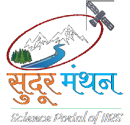G.E. Hutchinson, a renowned ecologist, once remarked, “Field ecology labs are essential for budding ecologists. The lessons learned in a field ecology lab stay with students or young researchers forever. It is where they develop their critical thinking skills, observation prowess, and problem-solving abilities essential for any aspiring ecologist.“
This philosophy underpins the functioning of Field Ecological Laboratory (FEL) at the Indian Institute of Remote Sensing.
The FEL represents an important infrastructure to integrate practical with scientific methodologies for students and researchers to gain hands-on experience in ecological research. Through direct interaction with natural systems and state-of-the-art instruments, learners develop critical observation skills, scientific writing proficiency, and collaborative working abilities. These foundational skills are essential for generating interest in budding ecologists.
The site comprised of semi-natural vegetation consisting of mixed-herbaceous vegetation and woodland. The FEL is promoting ecological research and its dissemination in the educational and outreach activities of IIRS. The site also facilitate live-demonstration and testing of various scientific instruments. The following scientific instruments and facilities are currently measure and observe the composition and diversity, structure, function and response of the ecosystem:
Ecosystem Composition & Diversity:
- Sampling Quadrats: The observation on plant community dynamics is gathered using sampling quadrats as per standard sampling protocols. By monitoring plant communities, their distribution patterns, and seasonal changes, a deeper understanding of ecosystem dynamics and biodiversity is obtained.
Ecosystem Structure:
- Dendrometers: The trees are tags with dendrometers to measure the girth increment of trees, offering insights into tree growth rates and health over time.
Ecosystem Functions:
- Microclimatic Sensors: The temperature (both soil and air) and relative humidity sensors are installed to observe the microclimate within the FEL.
- Photosynthesis System: Observations across the day and season, help to understand the light-use efficiencies of native plants and weeds. Such measurements are vital for understanding carbon cycling and the overall health of the ecosystem.
- Sap Flow Meter: Sap flow meter observations from Lagerstroemia speciosa show that sap flow rate declined with the shedding of leaves of the species (figure below), the recorded sap flow rate was zero with complete leaf fall. An increase in sap flow rate was observed with the appearance of leaves by the first week of April. This finding answers the question why deciduous trees shed leaves to cope with water shortage in summer.

- Soil Respiration System: This instrument is being used by students to determine the seasonal trends of CO2 flux from the roots and microbial fauna in the soil.
Ecosystem Response:
- Open Top Chambers (OTCs): As part of the Mountain Ecosystem Project of DOS, two OTCs have been set up at FEL. The idea is to compare the differential response of tropical and alpine vegetation (established near Gangotri) to experimental warming. Interestingly, OTCs at FEL simulated a lesser degree of warming compared to OTCs set up at Gangotri. It would be interesting to observe the effects of this slight increase in temperature on the phenology, physiology, and phytosociology of mixed herbaceous flora in a tropical environment.



